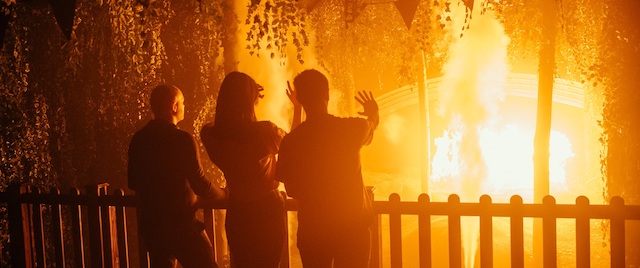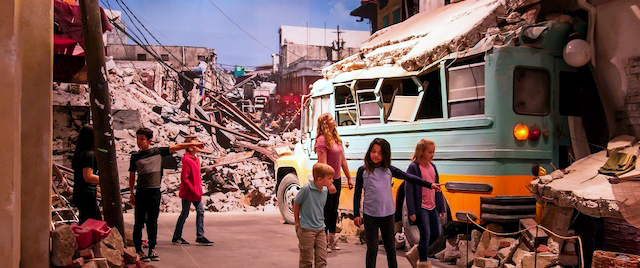Designing any themed attraction can be an audacious task, but the three attractions featured in today's Thea Awards Case Studies take audacity of concept to new levels.
How about reassembling a commercial airline fuselage inside a narrow corridor as the introduction to a walkthrough of physical sets recreating some of the poorest communities on Earth? The idea is to immerse visitors — including many schoolchildren — into witnessing and truly understanding extreme poverty, but without breaking them emotionally and instead leaving them feeling empowered to help.
Or how about creating a two-hour, mixed-media, interactive theater creation of The War of the Worlds, using virtual reality, escape rooms, projection mapping, audio and other sensory effects, and live theater to make visitors feel like they're fighting a Martian invasion? And, oh yeah, throw in a couple of bars so that visitors can down a pint or drink along the way.
Not audacious enough for you? Okay, how about building a full-fledged, animatronic three-minute dark ride for a four-day trade show, one that will be built on the top floor of a two-story, 38,000-square-foot temporary structure on a convention center parking lot? And the whole project will move from concept to completion in just three months.
This might be the ultimate in the audacity of themed entertainment design. And in Block Four of the Themed Entertainment Association's Thea Awards Digital Case Studies this morning, viewers learned how the teams behind these three projects made them happen.
Let's start with The Google Assistant Ride, which blew up the Internet when it ran at the Consumer Electronics Show in Las Vegas last year. A three-minute dark ride illustrating a family's use of Google's personal assistant technology over the course of a day, the attraction ran for just the four days of the show. But it lives on through on-ride videos that have racked up millions of views.
"We decided to bring a little bit of an analog feel to a very digital environment," Senior Creative Strategist Marcelo Alba said of the animatronic-driven attraction.
"We are asking for people for their time, and that is the most valuable thing they could be giving us, so we better damn well make it worth it," he said. "So how do we bring them real value in that moment, to that place, to those people? Sometimes it can be by giving them a product. Sometimes it can be by just giving them a joyful distraction — which we can all use right now, frankly. And so, how do you bring them something that they can remember, and that they say, this wasn't just a marketing thing; this was something that I actually felt, and I felt real value from. And I think and I hope that this ride really did that for folks at CES."
Alba and Lead Producer Anne Kelly talked through the three-month development and design process, which began as Google managers wanted to plus the previous year's CES display to illustrate Google Assistant's value to consumers' everyday life, beyond its ubiquity on platforms. The team quickly settled on the idea of a physical ride to illustrate a family's day, but had to dispense with traditional design moments such as feasibility, blue sky, and 2-D design drawings, Kelly said.
"We had time to design it, and we had time to build it. As such, we had to start in 3D immediately, and work entirely in previsualization," said Kelly, a former Walt Disney Imagineer. The Google team employed Colorado's Wisdom Rides to build the ride track and vehicles, which included on-board audio and video, which had to be synched with 3D-printed and custom-fabricated show scenes.
"Working in 3D from the beginning meant that we could use a lot of shortcuts in the show set fabrication," Kelly said. "We could use CNC routing; we could use 3D printing processes to just shortcut a lot of that sculpting and that fabrication process.
"One of the things that we learned in that process is that we knew we weren't going to have time or budget for a lot of complexity in the show set, and so if you can't afford detail, you just tend to go big. So we scaled things up and made it all larger than life, and a really charming scale to experience from the vehicle."
"It was the most bananas installation I've ever been a part of," Kelly said.

Jeff Wayne's The War of the Worlds: The Immersive Experience employs just about every weapon in a themed entertainment designer's arsenal to bring visitors into H.G. Wells' classic story, by way of Jeff Wayne's 1978 musical work.
"This is about escape," said Andrew McGuinness, the CEO of Ellipsis Entertainment, which created the production. "From the moment they step into our experience, they are in a different place. When they step into our bar, they're back in Victorian Britain and they remain in that escape world for the whole period that they're with us."
But while the production offers visitors a figurative escape, it should not allow them an actual one. That creates a challenge for designers of highly interactive experiences.
"You have to give [the audience] a certain amount of freedom, but then also control that freedom," Chief Creative Technologist Carl Guyenette said. "Sometimes they would walk out into different sets and open different doors and just walk through wherever they wanted to go — out of timings of the show. So we knew that we needed to get in locks on the doors that would open up at certain times, to make sure that they can only go to certain parts of the show at certain points."
And new technology should not distract designers from time-tested fundamentals of storytelling, McGuinness said.
"We want to tell something that is movie length, because there's a reason why things are that length. There's a reason why Shakespeare plays tend to be at that length, a reason why books tend to be a certain length," he said. "It's because people have time to be able to slip into that world and really immerse themselves in those stories.
"The tools that we will use to tell the stories will change," he said. "But the fundamental rules of storytelling and theater and those sort of things — we are very, very respectful of those things. Just because you're using new technology doesn't mean that the bounds of storytelling have dissolved."

The Children's Hunger Fund's Poverty Encounter brings audiences in Southern California face-to-face with poverty that few in America ever experience. It does so through a 90-minute, guided walkthrough of physical and mixed media scenes, starting with an airplane flight to garbage dump in Guatemala, the aftermath of an earthquake in Haiti, a brickyard in Nepal, and the sewers of Romania where orphans live.
"There were three things that we really wanted to get right," Children's Hunger Fund Founder and President Dave Phillips said. "The first was the theming element. We wanted to create sets that would really be authentic and would communicate well and would not in any way marginalize the poor and the stories that we were telling. The second element is the video piece. The videos have to connect the visitor personally to that child who lives in poverty. And then the third element is the facilitator, who helps the visitor process what they're experiencing throughout the exhibit."
"There's a very human element to poverty, and it really elicits raw emotion," he said. "It's completely overwhelming for all of us when we think about how many people live in poverty. We didn't want to elicit that emotion in the heart of our visitors and leave them with this sense of hopelessness or despair."
So creators designed the experience so that the final "scene," if you will, is a call to action, in which all visitors can help pack meals that the Children's Hunger Fund will send to churches in affected communities to help feed people in need.
"As a faith-based organization, this not only fulfills our mission but what God calls us to do, which is to love others and serve the needs of the poor."
The Thea Awards Digital Case Studies continue October 8 with sessions on Thea Award for Technical Innovation winner Christie Eclipse 4K RGB Pure Laser Projector and with TEA Peter Chernack Distinguished Service Award winner Wendy Heimann-Nunes.
Sessions continue October 22 with a focus on Attractions winners, including Wonderbox at South Korea's Paradise City, Popcorn Revenge at Walibi Belgium, and Hagrid’s Magical Creatures Motorbike Adventure. The series concludes November 5 with sessions on Thea Award winners Warner Bros. World Abu Dhabi, Millennium Falcon: Smugglers Run, and Star Wars: Galaxy's Edge. Tickets are available at the TEA website and include on-demand access to all previous 2020 Digital Case Study sessions.
* * *
Notice that we wanted you to read this article before we make our newsletter pitch, unlike so many other websites. If you appreciate that — and our approach to covering theme park news — please sign up for our three-times-a-week email newsletter. Thank you.
This article has been archived and is no longer accepting comments.